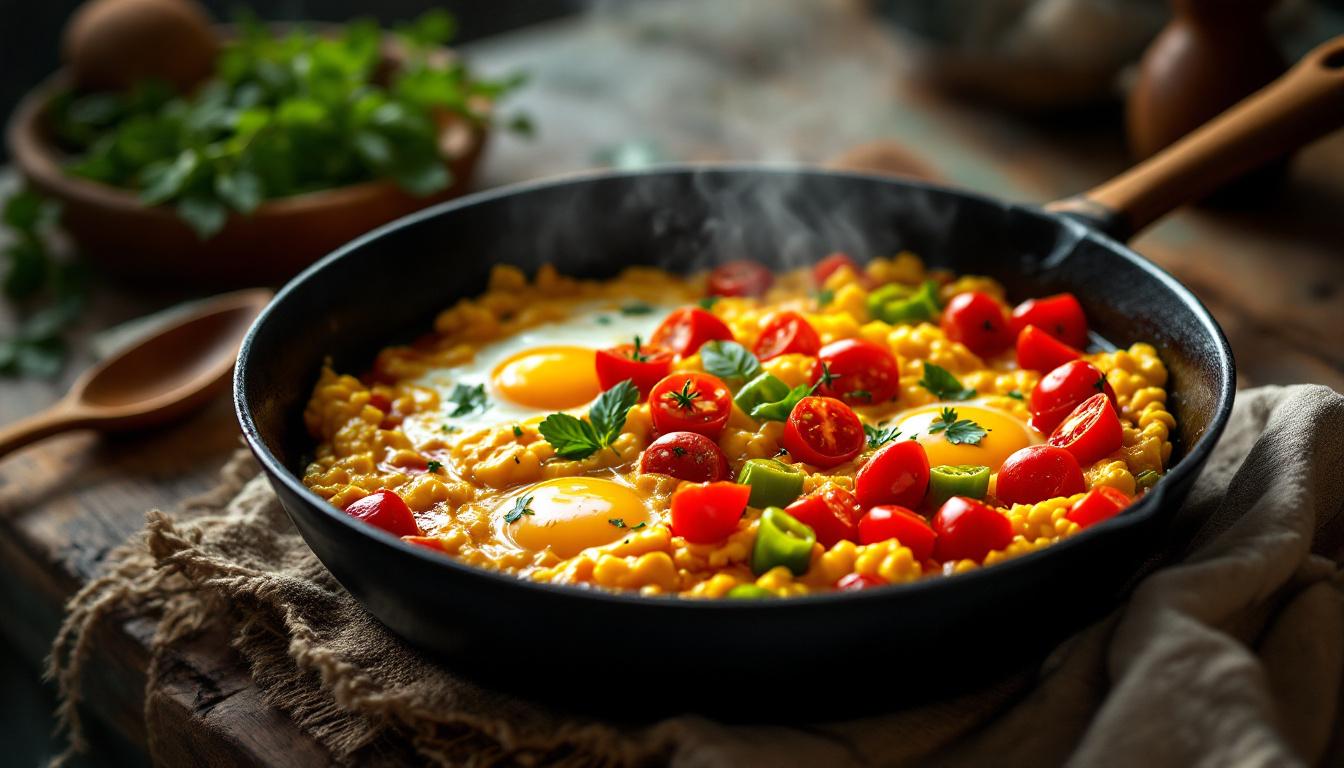The first time I encountered authentic Basque Piperade was during a culinary expedition through the French-Spanish border. What struck me wasn’t just its vibrant colors – the crimson tomatoes melting into golden eggs – but how such humble ingredients created something so profoundly satisfying. This isn’t just a pepper and egg dish; it’s a celebration of slow cooking that transforms simple ingredients into something magical. The secret? The long, patient reduction of tomatoes and the gentle folding of eggs that creates a silky, almost cloud-like texture you can’t achieve with quick cooking.
The Story 📖
Piperade originates from Basque Country, where it began as a clever way to use summer’s abundant harvest. The name comes from the Basque word “biper” (pepper), highlighting the starring ingredient. What makes traditional Piperade special is the use of specific mild Basque peppers rather than regular bell peppers – though good substitutes can work when cooking outside the region. This is grandmotherly cooking at its best: simple ingredients transformed through technique and patience.
Ingredients Spotlight 🧪
For 4 servings:
- 6 mild green peppers (Anaheim or Italian frying peppers make good substitutes) (about 1 lb/450g)
- 3¼ lbs (1.5kg) ripe tomatoes
- 1 large onion, thinly sliced (about 8oz/225g)
- 3 garlic cloves, finely chopped
- 1 tsp Espelette pepper (substitute with sweet paprika and a pinch of cayenne)
- 1 oz (30g) sugar (about 2 Tbsp)
- 6 large eggs
- 3 Tbsp olive oil
- Salt to taste
Step-by-Step Guide 📝
1. Prepare the vegetables: Remove seeds from peppers and slice into strips. Blanch tomatoes in boiling water for 30 seconds, shock in ice water, then peel and dice them.
2. Begin the slow cook: Heat olive oil in a wide, heavy-bottomed pan over medium-low heat. Add onions and cook for 5 minutes until translucent. Add garlic and peppers, cooking for another 10 minutes until they begin to soften.
3. Develop the base: Add tomatoes and a pinch of salt. Reduce heat to low and cook for 60-90 minutes, stirring occasionally. This slow reduction is essential – the mixture should become rich and concentrated, with most liquid evaporated.
4. Season: Add sugar to balance acidity and stir in the Espelette pepper. Taste and adjust salt as needed.
5. Add eggs: Create small wells in the vegetable mixture and crack eggs directly into them. Using a wooden spoon, gently fold and scramble the eggs through the sauce for 3-5 minutes until just set but still creamy.
Expert Techniques 🛠️
The magic of Piperade lies in two critical techniques. First, the long, slow reduction of tomatoes – what Basque grandmothers call “faire bouillir” (to boil down) – concentrates flavors and creates a jammy consistency. Second, the eggs must be folded gently, not scrambled aggressively. They should form soft, billowy curds that retain moisture. A wooden spoon is traditional and prevents the eggs from cooking too quickly.
Chef’s Note: The sugar quantity might seem high, but it’s traditional and necessary to balance the natural acidity of tomatoes. I like to add half at first, then taste and adjust. If your tomatoes are particularly sweet and ripe, you might need less.
Presentation & Pairing Ideas 🍽️
Serve Piperade straight from the pan in the center of the table, family-style, with crusty bread or steamed potatoes on the side. A dry white wine like Jurançon from the Basque region makes an excellent companion, as its bright acidity cuts through the richness of the eggs while complementing the sweetness of the peppers. For a modern twist, try serving individual portions in small cast iron skillets with a garnish of fresh herbs.
For a heartier variation, you can add thin slices of jamón or prosciutto just before the eggs. Vegetarians might enjoy adding crumbled goat cheese instead. In spring, fresh fava beans make a wonderful addition; in fall, sautéed mushrooms bring earthiness to the dish.
Remember, authentic Piperade isn’t about precision as much as it is about feeling. The vegetables should collapse into a harmonious fusion, and the eggs should retain their individual identity while becoming part of the whole. Trust your senses – when the kitchen fills with a sweet, garlicky aroma and the colors deepen to a rustic burgundy, you’ll know you’re on the right track. This is cooking that connects you to generations past while nourishing those gathered at your table today. 🍳✨
